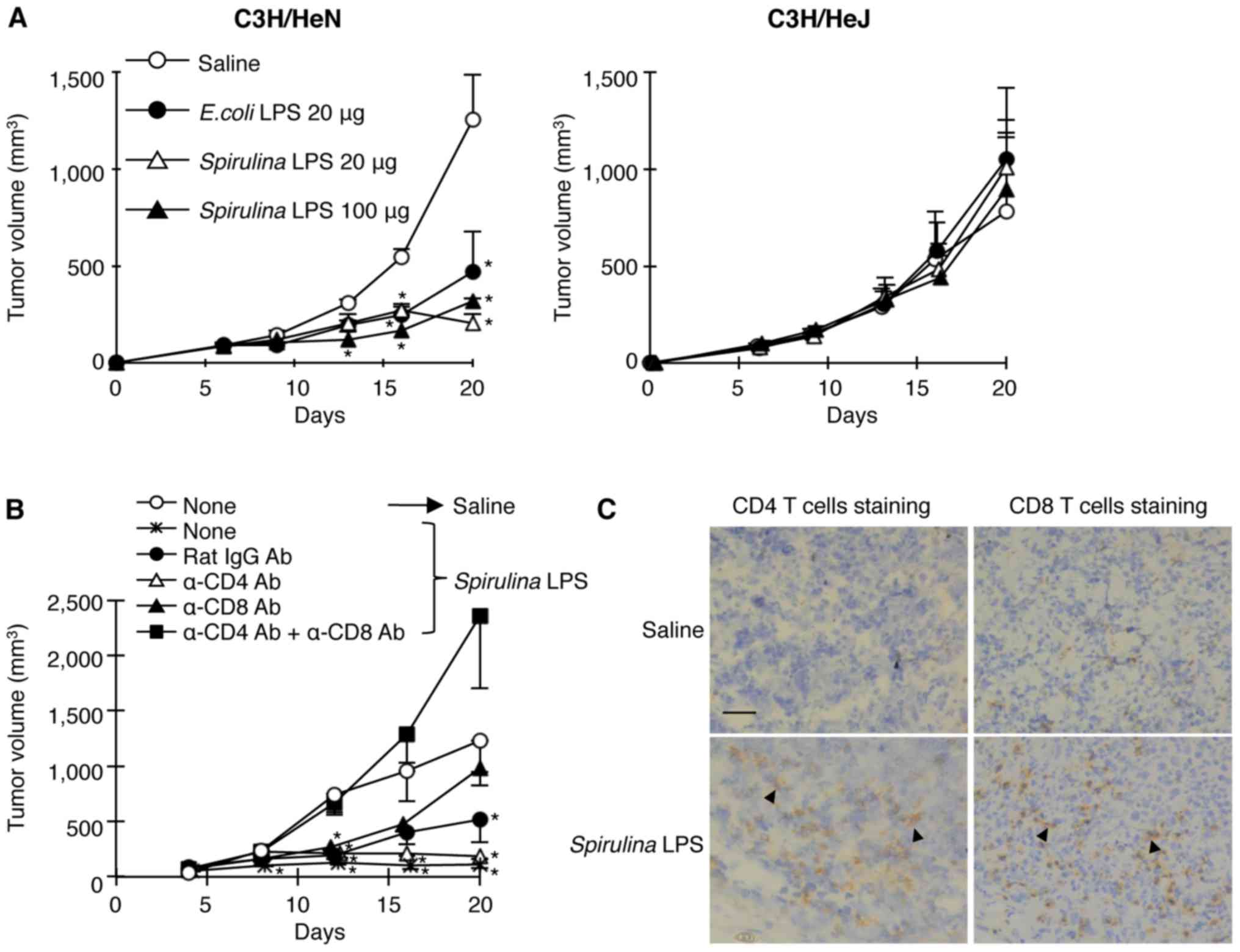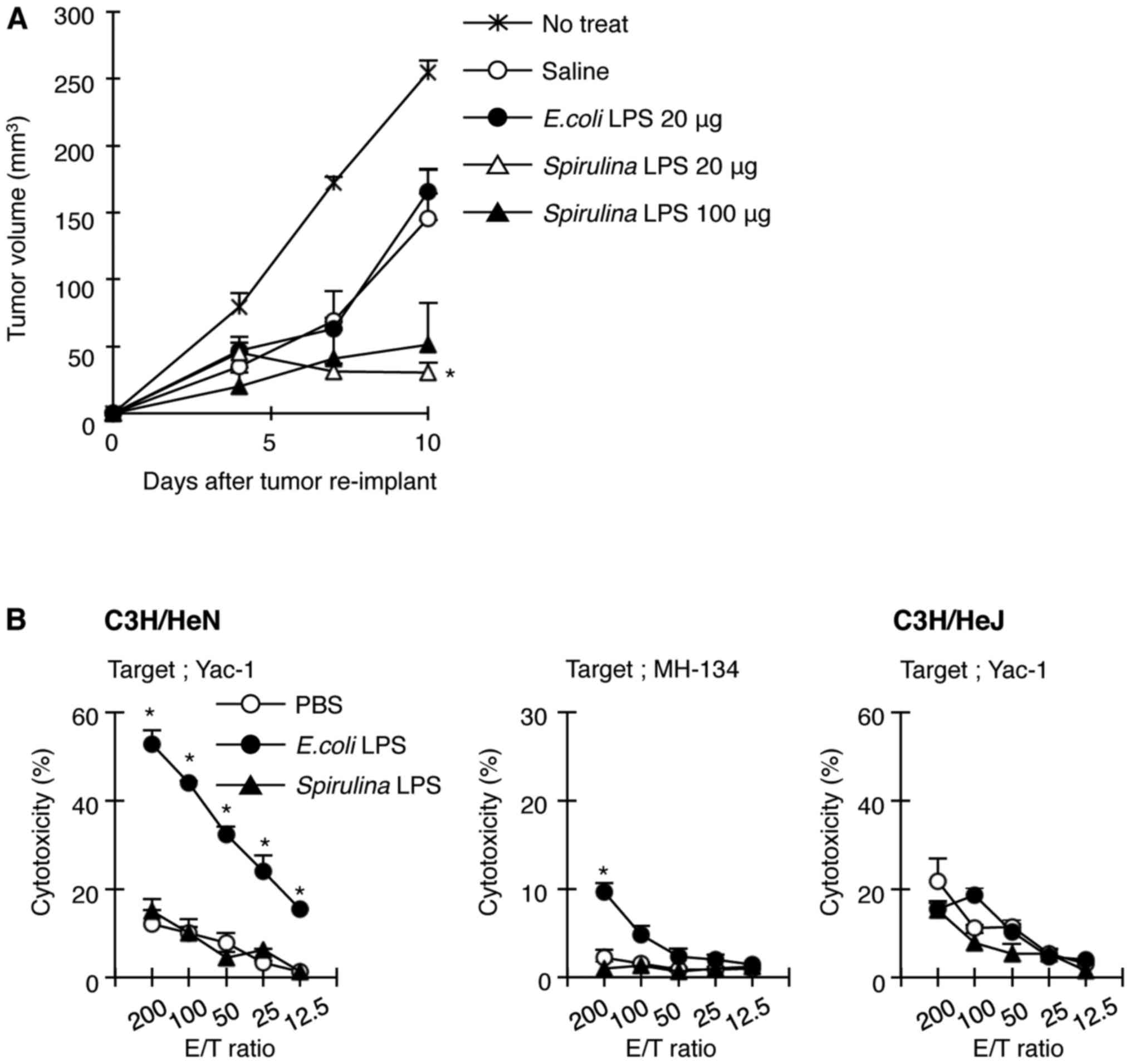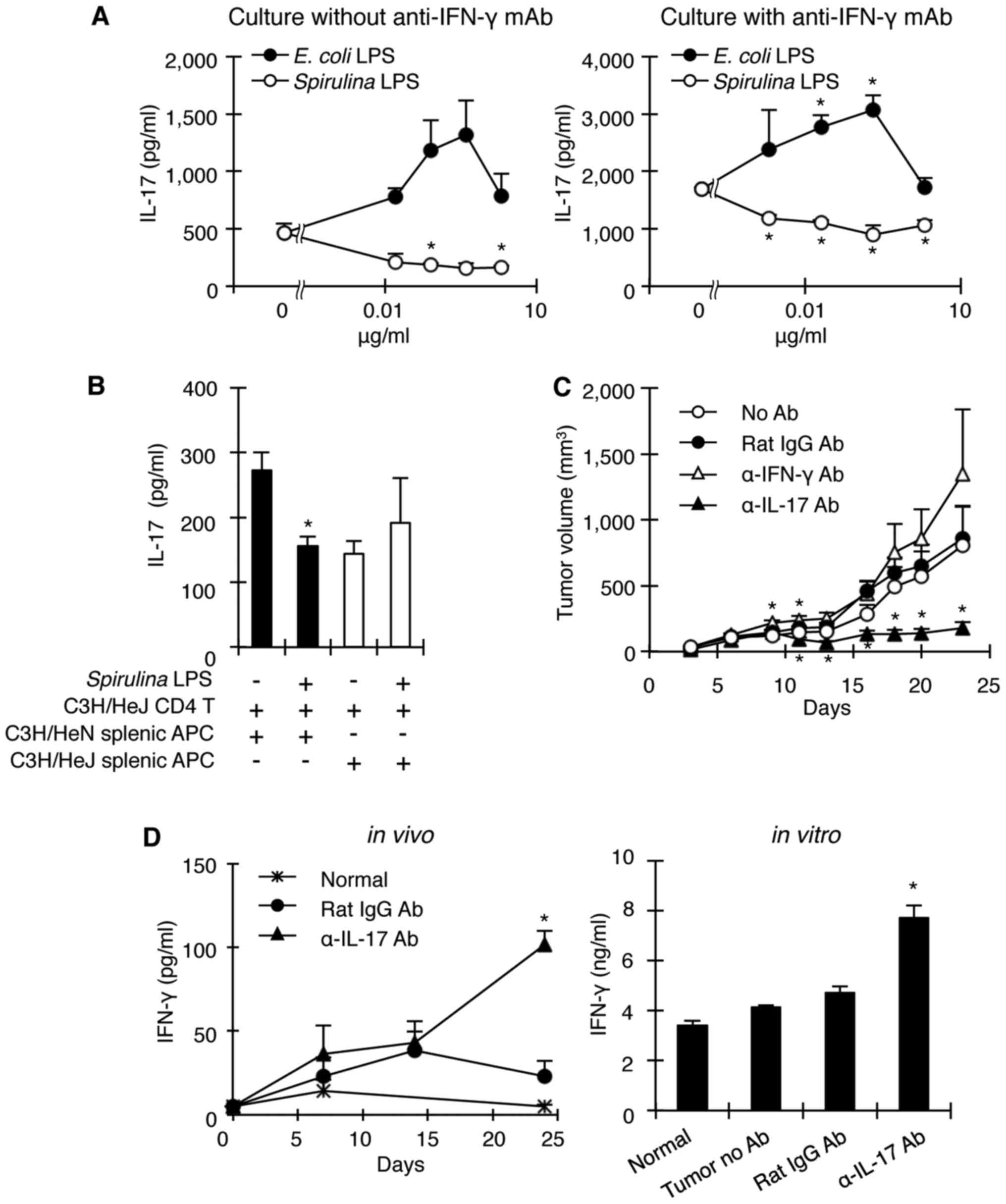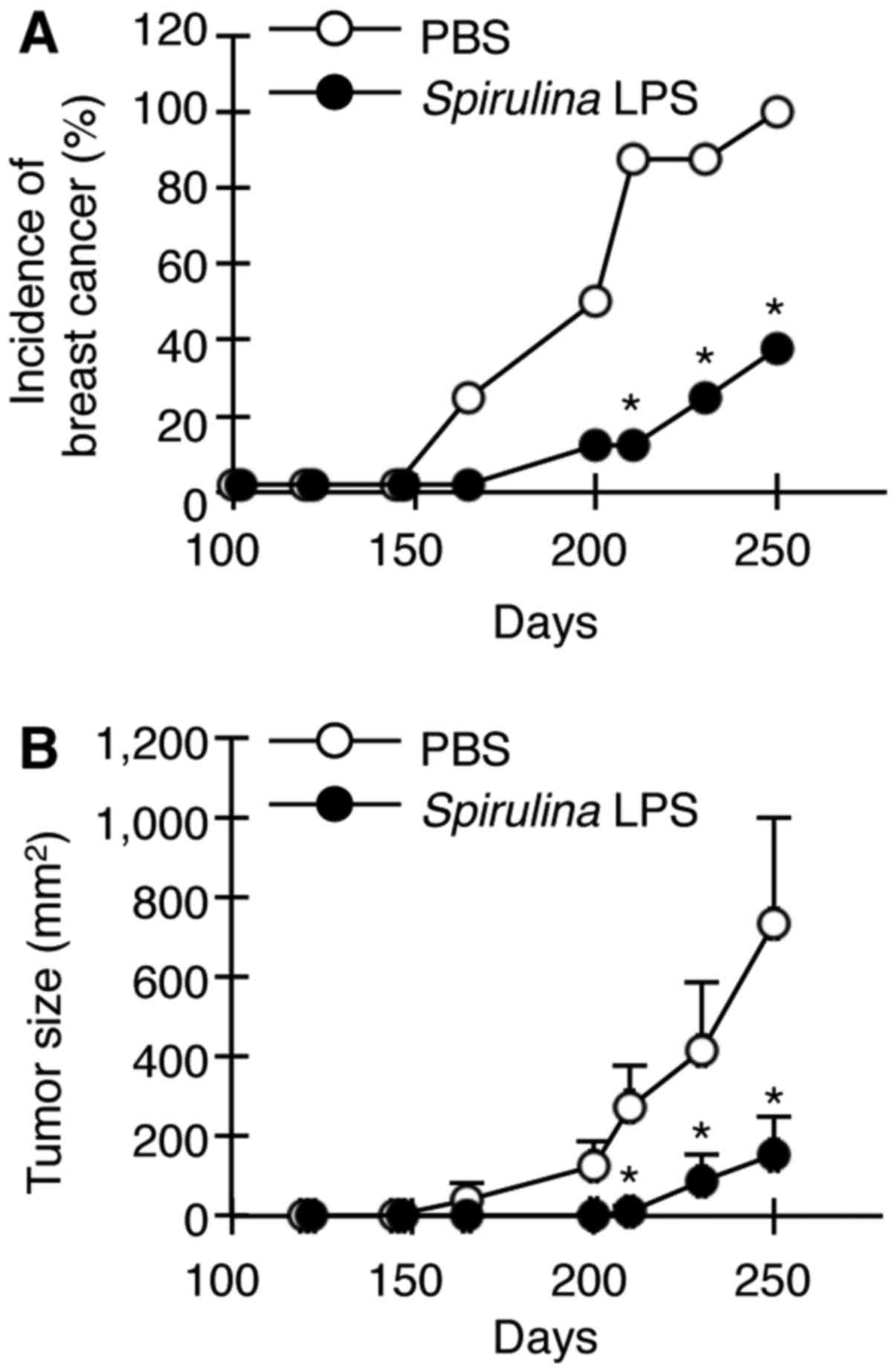|
1
|
Sylvester RJ, van der Meijden AP, Witjes
JA and Kurth K: Bacillus calmette-guerin versus chemotherapy for
the intravesical treatment of patients with carcinoma in situ of
the bladder: A meta-analysis of the published results of randomized
clinical trials. J Urol. 174:86–91; discussion 91–92. 2005.
View Article : Google Scholar : PubMed/NCBI
|
|
2
|
Medzhitov R and Janeway CA Jr: Innate
immunity: The virtues of a nonclonal system of recognition. Cell.
91:295–298. 1997. View Article : Google Scholar : PubMed/NCBI
|
|
3
|
Akira S, Takeda K and Kaisho T: Toll-like
receptors: Critical proteins linking innate and acquired immunity.
Nat Immunol. 2:675–680. 2001. View
Article : Google Scholar : PubMed/NCBI
|
|
4
|
Trinchieri G: Interleukin-12 and the
regulation of innate resistance and adaptive immunity. Nat Rev
Immunol. 3:133–146. 2003. View Article : Google Scholar : PubMed/NCBI
|
|
5
|
Dalton DK, Pitts-Meek S, Keshav S, Figari
IS, Bradley A and Stewart TA: Multiple defects of immune cell
function in mice with disrupted interferon-γ genes. Science.
259:1739–1742. 1993. View Article : Google Scholar : PubMed/NCBI
|
|
6
|
Shankaran V, Ikeda H, Bruce AT, White JM,
Swanson PE, Old LJ and Schreiber RD: IFNgamma and lymphocytes
prevent primary tumour development and shape tumour immunogenicity.
Nature. 410:1107–1111. 2001. View Article : Google Scholar : PubMed/NCBI
|
|
7
|
Dighe AS, Richards E, Old LJ and Schreiber
RD: Enhanced in vivo growth and resistance to rejection of tumor
cells expressing dominant negative IFN γ receptors. Immunity.
1:447–456. 1994. View Article : Google Scholar : PubMed/NCBI
|
|
8
|
Mizuno D, Yoshioka O, Akamatu M and
Kataoka T: Antitumor effect of intracutaneous injection of
bacterial lipopolysaccharide. Cancer Res. 28:1531–1537.
1968.PubMed/NCBI
|
|
9
|
Ohnishi M, Kimura S, Yamazaki M, Oshima H,
Mizuno DI, Abe S and Yamaguchi H: Anti-tumour activity of
low-toxicity lipopolysaccharide of Bordetella pertussis. Br J
Cancer. 69:1038–1042. 1994. View Article : Google Scholar : PubMed/NCBI
|
|
10
|
Yang D, Satoh M, Ueda H, Tsukagoshi S and
Yamazaki M: Activation of tumor-infiltrating macrophages by a
synthetic lipid A analog (ONO-4007) and its implication in
antitumor effects. Cancer Immunol Immunother. 38:287–293. 1994.
View Article : Google Scholar : PubMed/NCBI
|
|
11
|
Tartour E, Fossiez F, Joyeux I, Galinha A,
Gey A, Claret E, Sastre-Garau X, Couturier J, Mosseri V, Vives V,
et al: Interleukin 17, a T-cell-derived cytokine, promotes
tumorigenicity of human cervical tumors in nude mice. Cancer Res.
59:3698–3704. 1999.PubMed/NCBI
|
|
12
|
Kato T, Furumoto H, Ogura T, Onishi Y,
Irahara M, Yamano S, Kamada M and Aono T: Expression of IL-17 mRNA
in ovarian cancer. Biochem Biophys Res Commun. 282:735–738. 2001.
View Article : Google Scholar : PubMed/NCBI
|
|
13
|
Numasaki M, Watanabe M, Suzuki T,
Takahashi H, Nakamura A, McAllister F, Hishinuma T, Goto J, Lotze
MT, Kolls JK, et al: IL-17 enhances the net angiogenic activity and
in vivo growth of human non-small cell lung cancer in SCID mice
through promoting CXCR-2-dependent angiogenesis. J Immunol.
175:6177–6189. 2005. View Article : Google Scholar : PubMed/NCBI
|
|
14
|
Langowski JL, Zhang X, Wu L, Mattson JD,
Chen T, Smith K, Basham B, McClanahan T, Kastelein RA and Oft M:
IL-23 promotes tumour incidence and growth. Nature. 442:461–465.
2006. View Article : Google Scholar : PubMed/NCBI
|
|
15
|
He D, Li H, Yusuf N, Elmets CA, Li J,
Mountz JD and Xu H: IL-17 promotes tumor development through the
induction of tumor promoting microenvironments at tumor sites and
myeloid-derived suppressor cells. J Immunol. 184:2281–2288. 2010.
View Article : Google Scholar : PubMed/NCBI
|
|
16
|
Wang L, Yi T, Kortylewski M, Pardoll DM,
Zeng D and Yu H: IL-17 can promote tumor growth through an
IL-6-Stat3 signaling pathway. J Exp Med. 206:1457–1464. 2009.
View Article : Google Scholar : PubMed/NCBI
|
|
17
|
Kortylewski M, Xin H, Kujawski M, Lee H,
Liu Y, Harris T, Drake C, Pardoll D and Yu H: Regulation of the
IL-23 and IL-12 balance by Stat3 signaling in the tumor
microenvironment. Cancer Cell. 15:114–123. 2009. View Article : Google Scholar : PubMed/NCBI
|
|
18
|
Kastelein RA, Hunter CA and Cua DJ:
Discovery and biology of IL-23 and IL-27: Related but functionally
distinct regulators of inflammation. Annu Rev Immunol. 25:221–242.
2007. View Article : Google Scholar : PubMed/NCBI
|
|
19
|
Korn T, Bettelli E, Oukka M and Kuchroo
VK: IL-17 and Th17 Cells. Annu Rev Immunol. 27:485–517. 2009.
View Article : Google Scholar : PubMed/NCBI
|
|
20
|
Bettelli E, Carrier Y, Gao W, Korn T,
Strom TB, Oukka M, Weiner HL and Kuchroo VK: Reciprocal
developmental pathways for the generation of pathogenic effector
TH17 and regulatory T cells. Nature. 441:235–238. 2006. View Article : Google Scholar : PubMed/NCBI
|
|
21
|
Goriely S, Neurath MF and Goldman M: How
microorganisms tip the balance between interleukin-12 family
members. Nat Rev Immunol. 8:81–86. 2008. View Article : Google Scholar : PubMed/NCBI
|
|
22
|
Kelly MG, Alvero AB, Chen R, Silasi DA,
Abrahams VM, Chan S, Visintin I, Rutherford T and Mor G: TLR-4
signaling promotes tumor growth and paclitaxel chemoresistance in
ovarian cancer. Cancer Res. 66:3859–3868. 2006. View Article : Google Scholar : PubMed/NCBI
|
|
23
|
Yu H, Kortylewski M and Pardoll D:
Crosstalk between cancer and immune cells: Role of STAT3 in the
tumour microenvironment. Nat Rev Immunol. 7:41–51. 2007. View Article : Google Scholar : PubMed/NCBI
|
|
24
|
Tominaga A, Okuyama H, Fukuoka S, Taguchi
T, Kusumoto Y, Shimizu K and Ono S: Effects of edible algae
polysaccharides on allergic, inflammatory, and anti-tumor responses
through toll-like receptor 4. Antiinflamm Antiallergy Agents Med
Chem. 9:238–250. 2010. View Article : Google Scholar
|
|
25
|
Stewart I, Schluter PJ and Shaw GR:
Cyanobacterial lipopolysaccharides and human health - a review.
Environ Health. 5:7–29. 2006. View Article : Google Scholar : PubMed/NCBI
|
|
26
|
Tornabene TG, Bourne TF, Raziuddin S and
Ben-Amotz A: Lipid and lipopolysaccharide constituents of
cyanobacterium Spirulina platensis (Cyanophyceae, Nostocales). Mar
Ecol Prog Ser. 22:121–125. 1985. View Article : Google Scholar
|
|
27
|
Westphal O and Jann K: Bacterial
lipopolysaccharides. Extraction with phenol-water and further
applications of the procedureMethods in Carbohydrate Chemistry.
Whistler RL and Wolfan ML: Academic Press Inc.; New York: pp.
83–91. 1965
|
|
28
|
Takeuchi N, Hiraoka S, Zhou XY, Nagafuku
M, Ono S, Tsujimura T, Nakazawa M, Yura Y, Hamaoka T and Fujiwara
H: Anti-HER-2/neu immune responses are induced before the
development of clinical tumors but declined following tumorigenesis
in HER-2/neu transgenic mice. Cancer Res. 64:7588–7595. 2004.
View Article : Google Scholar : PubMed/NCBI
|
|
29
|
Zou JP, Shimizu J, Ikegame K, Yamamoto N,
Ono S, Fujiwara H and Hamaoka T: Tumor-bearing mice exhibit a
progressive increase in tumor antigen-presenting cell function and
a reciprocal decrease in tumor antigen-responsive CD4+ T
cell activity. J Immunol. 148:648–655. 1992.PubMed/NCBI
|
|
30
|
Poltorak A, He X, Smirnova I, Liu MY, Van
Huffel C, Du X, Birdwell D, Alejos E, Silva M, Galanos C, et al:
Defective LPS signaling in C3H/HeJ and C57BL/10ScCr mice: Mutations
in Tlr4 gene. Science. 282:2085–2088. 1998. View Article : Google Scholar : PubMed/NCBI
|
|
31
|
Yamamoto N, Zou JP, Li XF, Takenaka H,
Noda S, Fujii T, Ono S, Kobayashi Y, Mukaida N, Matsushima K, et
al: Regulatory mechanisms for production of IFN-γ and TNF by
antitumor T cells or macrophages in the tumor-bearing state. J
Immunol. 154:2281–2290. 1995.PubMed/NCBI
|
|
32
|
Park H, Li Z, Yang XO, Chang SH, Nurieva
R, Wang YH, Wang Y, Hood L, Zhu Z, Tian Q, et al: A distinct
lineage of CD4 T cells regulates tissue inflammation by producing
interleukin 17. Nat Immunol. 6:1133–1141. 2005. View Article : Google Scholar : PubMed/NCBI
|
|
33
|
Harrington LE, Hatton RD, Mangan PR,
Turner H, Murphy TL, Murphy KM and Weaver CT: Interleukin
17-producing CD4+ effector T cells develop via a lineage
distinct from the T helper type 1 and 2 lineages. Nat Immunol.
6:1123–1132. 2005. View
Article : Google Scholar : PubMed/NCBI
|
|
34
|
Nakajima C, Uekusa Y, Iwasaki M, Yamaguchi
N, Mukai T, Gao P, Tomura M, Ono S, Tsujimura T, Fujiwara H, et al:
A role of interferon-γ (IFN-γ) in tumor immunity: T cells with the
capacity to reject tumor cells are generated but fail to migrate to
tumor sites in IFN-γ-deficient mice. Cancer Res. 61:3399–3405.
2001.PubMed/NCBI
|
|
35
|
O'Connor W Jr, Kamanaka M, Booth CJ, Town
T, Nakae S, Iwakura Y, Kolls JK and Flavell RA: A protective
function for interleukin 17A in T cell-mediated intestinal
inflammation. Nat Immunol. 10:603–609. 2009. View Article : Google Scholar : PubMed/NCBI
|
|
36
|
Kawanishi Y, Tominaga A, Okuyama H,
Fukuoka S, Taguchi T, Kusumoto Y, Yawata T, Fujimoto Y, Ono S and
Shimizu K: Regulatory effects of Spirulina complex polysaccharides
on growth of murine RSV-M glioma cells through Toll-like receptor
4. Microbiol Immunol. 57:63–73. 2013. View Article : Google Scholar : PubMed/NCBI
|
|
37
|
Odobasic D, Leech MT, Xue JR and
Holdsworth SR: Distinct in vivo roles of CD80 and CD86 in the
effector T-cell responses inducing antigen-induced arthritis.
Immunology. 124:503–513. 2008. View Article : Google Scholar : PubMed/NCBI
|
|
38
|
Stumhofer JS, Laurence A, Wilson EH, Huang
E, Tato CM, Johnson LM, Villarino AV, Huang Q, Yoshimura A, Sehy D,
et al: Interleukin 27 negatively regulates the development of
interleukin 17-producing T helper cells during chronic inflammation
of the central nervous system. Nat Immunol. 7:937–945. 2006.
View Article : Google Scholar : PubMed/NCBI
|
|
39
|
Martin-Orozco N, Muranski P, Chung Y, Yang
XO, Yamazaki T, Lu S, Hwu P, Restifo NP, Overwijk WW and Dong C: T
helper 17 cells promote cytotoxic T cell activation in tumor
immunity. Immunity. 31:787–798. 2009. View Article : Google Scholar : PubMed/NCBI
|
|
40
|
Muranski P, Boni A, Antony PA, Cassard L,
Irvine KR, Kaiser A, Paulos CM, Palmer DC, Touloukian CE, Ptak K,
et al: Tumor-specific Th17-polarized cells eradicate large
established melanoma. Blood. 112:362–373. 2008. View Article : Google Scholar : PubMed/NCBI
|
|
41
|
Murugaiyan G and Saha B: Protumor vs.
antitumor functions of IL-17. J Immunol. 183:4169–4175. 2009.
View Article : Google Scholar : PubMed/NCBI
|
|
42
|
Yao Z, Fanslow WC, Seldin MF, Rousseau AM,
Painter SL, Comeau MR, Cohen JI and Spriggs MK: Herpesvirus Saimiri
encodes a new cytokine, IL-17, which binds to a novel cytokine
receptor. Immunity. 3:811–821. 1995. View Article : Google Scholar : PubMed/NCBI
|
|
43
|
Kolls JK and Lindén A: Interleukin-17
family members and inflammation. Immunity. 21:467–476. 2004.
View Article : Google Scholar : PubMed/NCBI
|
|
44
|
Cirée A, Michel L, Camilleri-Bröet S,
Louis F Jean, Oster M, Flageul B, Senet P, Fossiez F, Fridman WH,
Bachelez H, et al: Expression and activity of IL-17 in cutaneous
T-cell lymphomas (mycosis fungoides and Sezary syndrome). Int J
Cancer. 112:113–120. 2004. View Article : Google Scholar : PubMed/NCBI
|
|
45
|
Netea MG, van Deuren M, Kullberg BJ,
Cavaillon JM and Van der Meer JW: Does the shape of lipid A
determine the interaction of LPS with Toll-like receptors? Trends
Immunol. 23:135–139. 2002. View Article : Google Scholar : PubMed/NCBI
|
|
46
|
Miller SI, Ernst RK and Bader MW: LPS,
TLR4 and infectious disease diversity. Nat Rev Microbiol. 3:36–46.
2005. View Article : Google Scholar : PubMed/NCBI
|
|
47
|
Schromm AB, Brandenburg K, Loppnow H,
Moran AP, Koch MH, Rietschel ET and Seydel U: Biological activities
of lipopolysaccharides are determined by the shape of their lipid A
portion. Eur J Biochem. 267:2008–2013. 2000. View Article : Google Scholar : PubMed/NCBI
|
|
48
|
Lebbar S, Cavaillon JM, Caroff M, Ledur A,
Brade H, Sarfati R and Haeffner-Cavaillon N: Molecular requirement
for interleukin 1 induction by lipopolysaccharide-stimulated human
monocytes: Involvement of the heptosyl-2-keto-3-deoxyoctulosonate
region. Eur J Immunol. 16:87–91. 1986. View Article : Google Scholar : PubMed/NCBI
|
|
49
|
Gangloff SC, Hijiya N, Haziot A and Goyert
SM: Lipopolysaccharide structure influences the macrophage response
via CD14-independent and CD14-dependent pathways. Clin Infect Dis.
28:491–496. 1999. View
Article : Google Scholar : PubMed/NCBI
|
|
50
|
Loppnow H, Libby P, Freudenberg M, Krauss
JH, Weckesser J and Mayer H: Cytokine induction by
lipopolysaccharide (LPS) corresponds to lethal toxicity and is
inhibited by nontoxic Rhodobacter capsulatus LPS. Infect Immun.
58:3743–3750. 1990.PubMed/NCBI
|
|
51
|
Mishima T, Murata J, Toyoshima M, Fujii H,
Nakajima M, Hayashi T, Kato T and Saiki I: Inhibition of tumor
invasion and metastasis by calcium spirulan (Ca-SP), a novel
sulfated polysaccharide derived from a blue-green alga, Spirulina
platensis. Clin Exp Metastasis. 16:541–550. 1998. View Article : Google Scholar : PubMed/NCBI
|
|
52
|
Akao Y, Ebihara T, Masuda H, Saeki Y,
Akazawa T, Hazeki K, Hazeki O, Matsumoto M and Seya T: Enhancement
of antitumor natural killer cell activation by orally administered
Spirulina extract in mice. Cancer Sci. 100:1494–1501. 2009.
View Article : Google Scholar : PubMed/NCBI
|
















